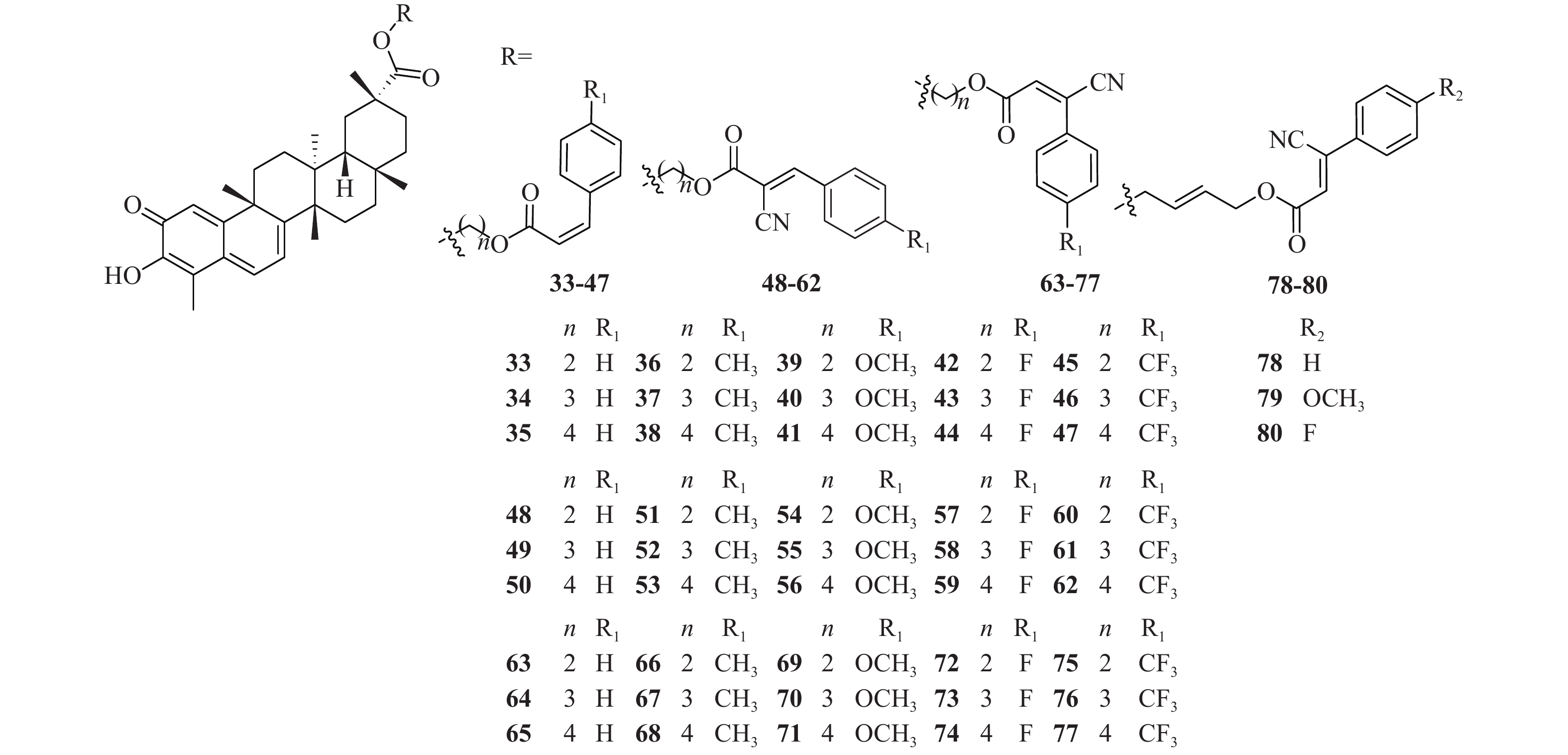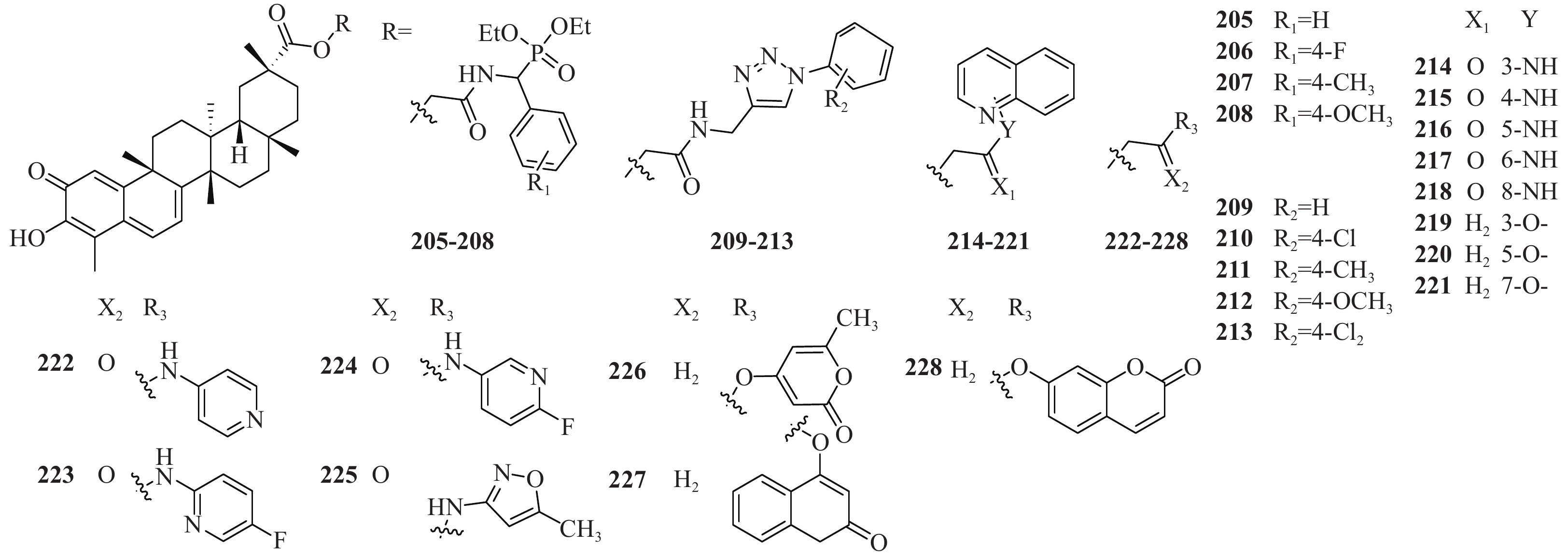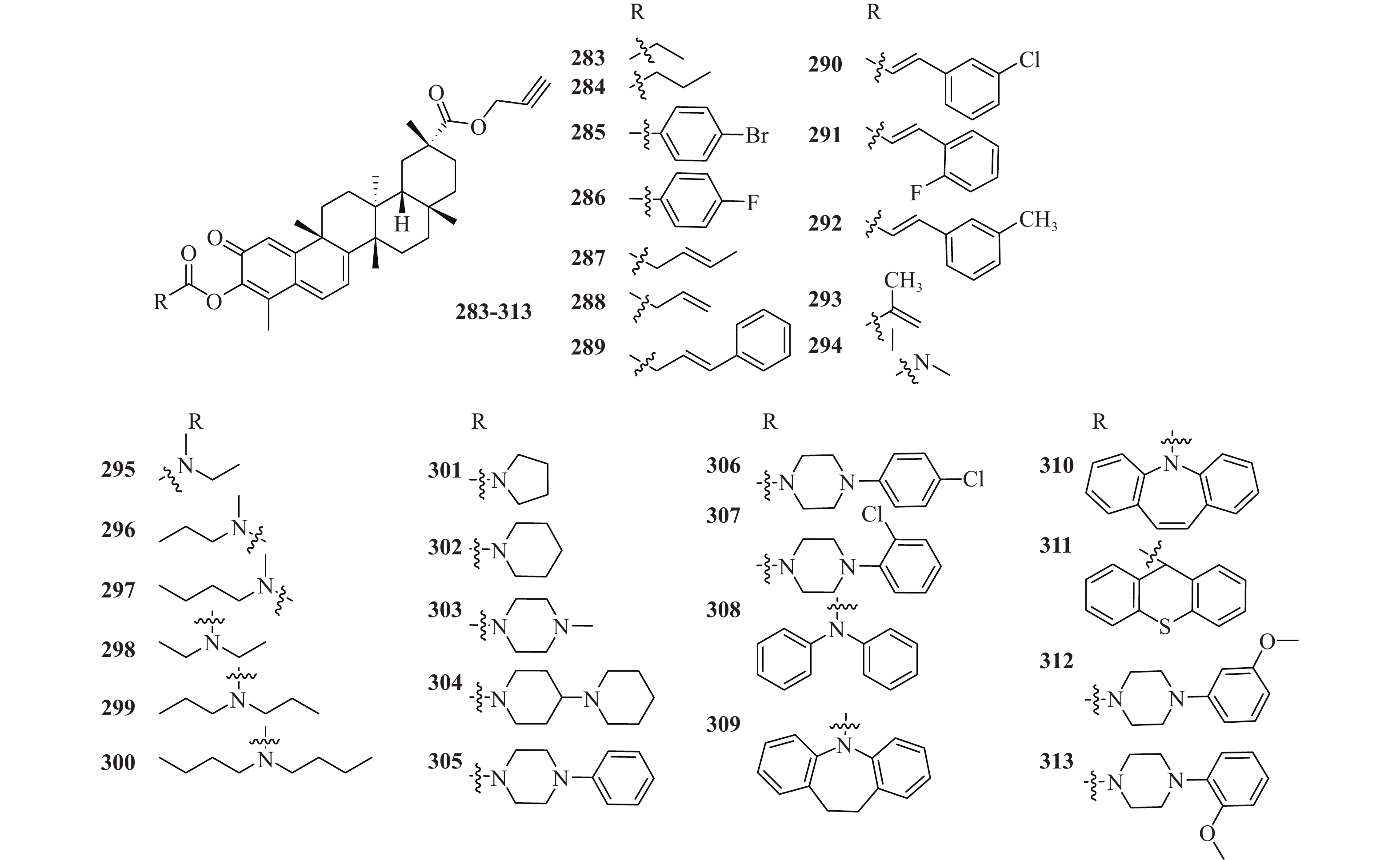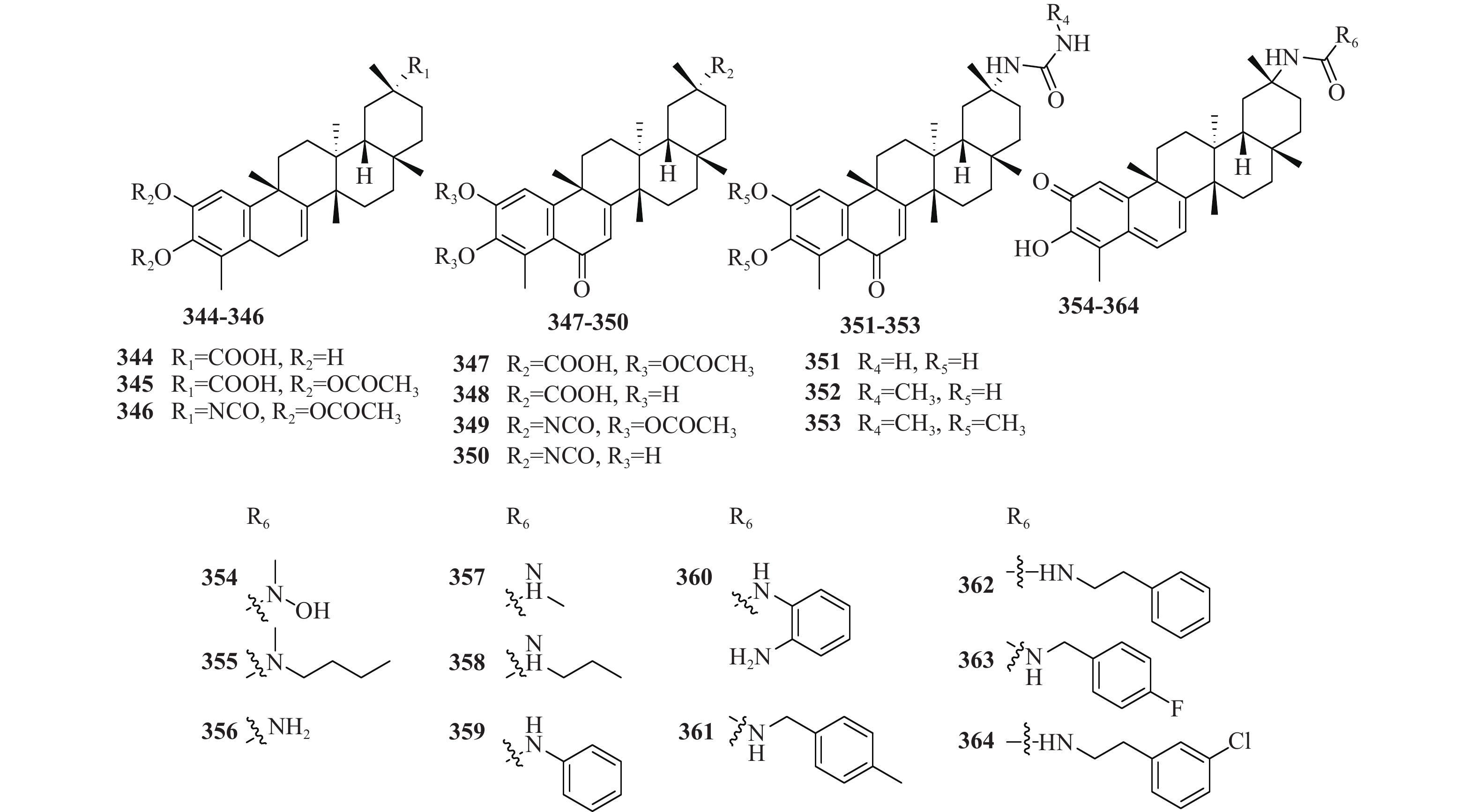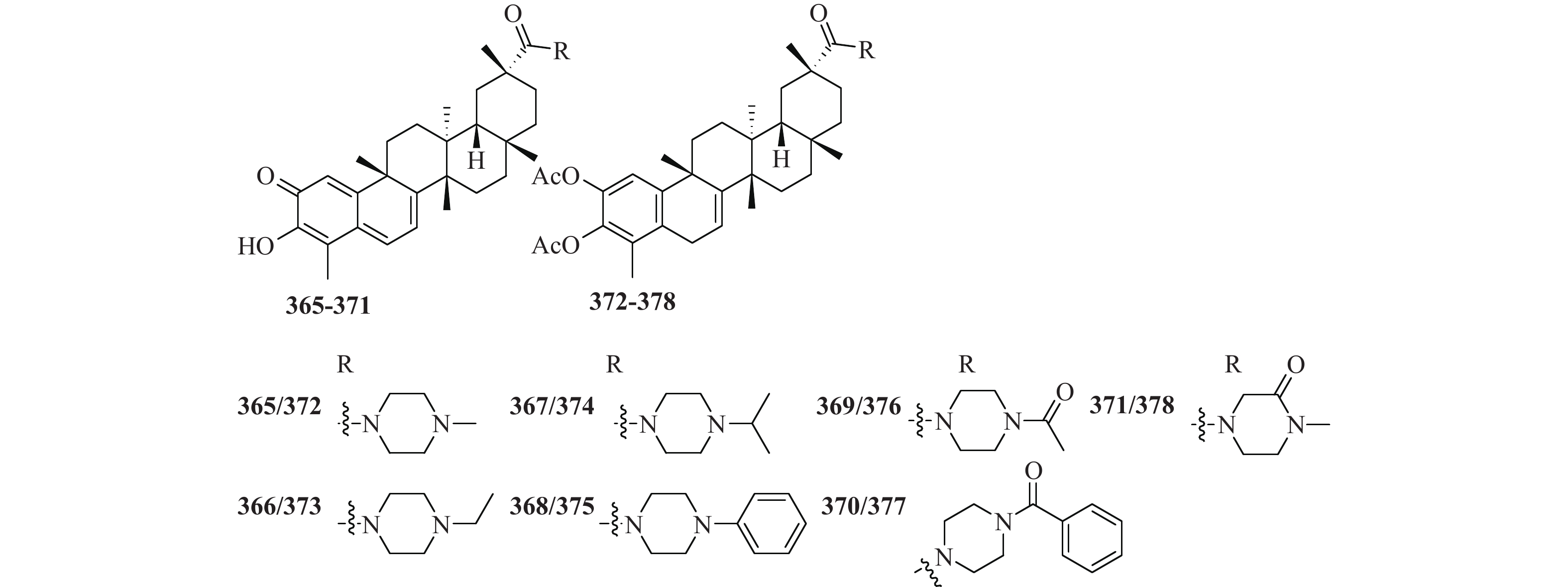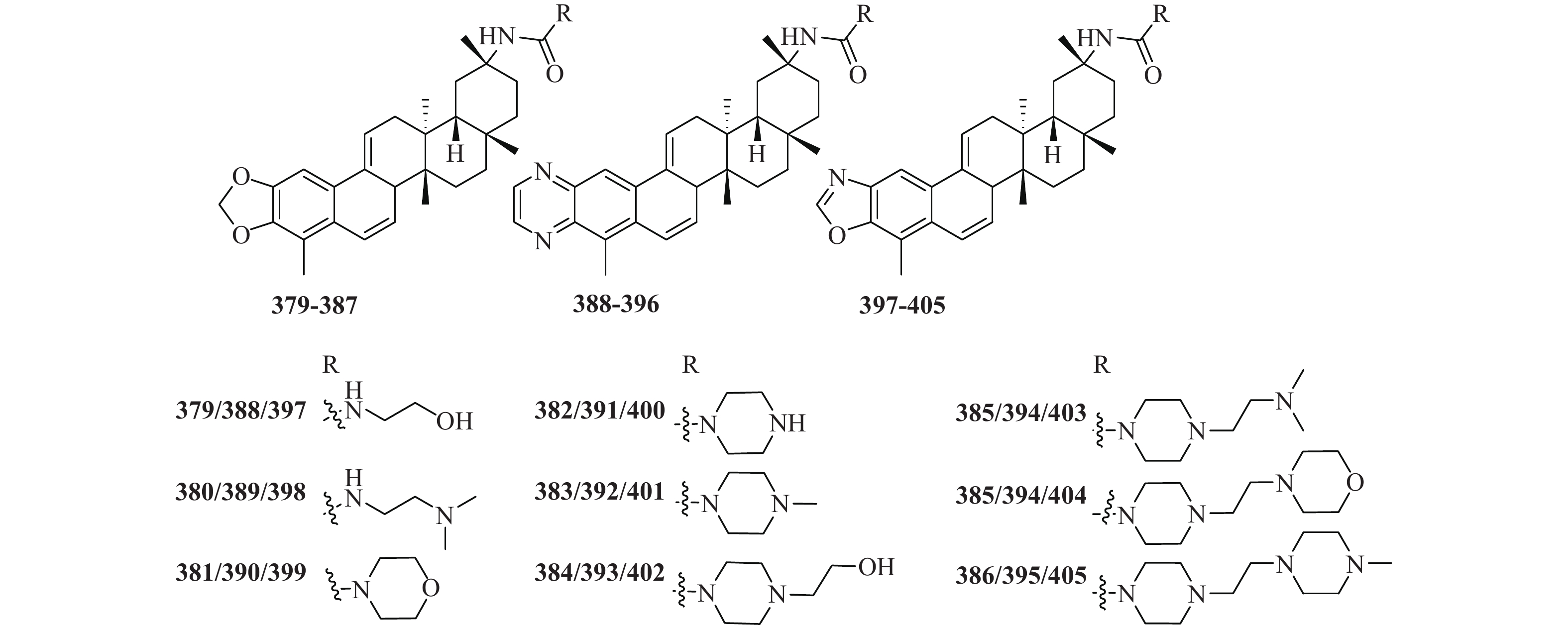Progress of research on celastrol derivatives as anti-tumor agents
-
摘要:
雷公藤红素是从中药雷公藤Tripterygium wilfordii Hook.f.根皮中分离得到的五环三萜类化合物,可抑制多种恶性肿瘤的生长,但也存在毒性大、水溶性差、靶向性欠佳等缺陷。因此,对其进行结构修饰是近年来的研究热点。已报道的雷公藤红素结构修饰主要集中在C-20-COOH及AB环的C-2、C-3、C-6位或多位点同时优化。本文主要依据不同的修饰位点、修饰目的(提高Hsp90-Cdc37 PPI抑制作用等)和修饰手段(基于骈和原理和特定靶点等),综述近年来雷公藤红素抗肿瘤类衍生物的研究进展。此外,还简要讨论了衍生物的抗肿瘤活性、作用机制和构效关系,以期能够为发现新的高效、低毒、选择性强的CEL衍生物提供理论指导。
Abstract:Celastrol, a pentacyclic triterpenoid compound derived from the root of Chinese herb Tripterygium wilfordii Hook.f.,can inhibit the growth of various types of malignant tumors. However, it still has some limitations, including high toxicity, poor water solubility, and low targeting efficiency. Therefore, structural modification of celastrol has become a research hotspot in recent years. The structural modifications of celstrol reported have focused on C-20-COOH and C-2, C-3, C-6 or multiple sites of AB ring. This review provides an overview of the research progress of anti-tumor celastrol derivatives in recent years according to different structural modification sites and purposes, such as enhancing the inhibitory effect on the Hsp90-Cdc37 protein-protein interaction, and modification methods, including principles of parallelism and targeting specific sites. In addition, it briefly discusses the antitumor activity, mechanism of action, and structure-activity relationship of these derivatives, aiming to provide theoretical guidance for the discovery of new celastrol derivatives with high efficiency, low toxicity, and strong selectivity.
-
Keywords:
- celastrol /
- anti-tumor /
- structural modification /
- structure activity relationship
-
药用辅料是制剂的重要组成部分,在绝大多数制剂处方中占比高达90%以上,承担着改善药物释放、充当制剂载体、保障制剂稳定性及提高患者用药顺应性的重要使命,是驱动药物性能的关键。
基于中药制剂工艺优化、剂型升级及临床疗效的多重需求,一些材料学、化学及药学等多学科前沿成果被引入了药用辅料的优化与开发中,用以改善辅料的性能。依据欧洲药品管理局(EMA)和国家药品监督管理局2019年第56号指导文件及相关文献[1−3],新型辅料的开发途径可总结包括:(1)开发新的分子结构;(2)对原有辅料进行化学或物理改性;(3)开发预混或共处理辅料;(4)改变给药途径等。鉴于辅料开发的成本及周期性,其中预混与共处理辅料、改性辅料等是目前新型辅料开发的主要方向。同时,在中药制剂药用辅料中,还存在“药辅合一”的独特用法,“药辅合一”辅料兼具制剂效应组分和制剂赋形剂的双重角色,独具中药特色。本文全面梳理与分析了上述各类辅料当前的研究进展及在中药制剂中的应用现状,以期为中药制剂药用辅料的选择及开发适于中药的个性化药用辅料提供参考。
1. 预混与共处理辅料
预混与共处理辅料系将2种或2种以上药用辅料按特定的配比和工艺制成的具有一定功能的混合物。预混辅料,仅为特定配方的物理混合物,而共处理辅料则会经过特殊的物理加工工艺如喷雾干燥等[2]。该类辅料开发成本相对较低、开发周期短,且可个性化定制,因此许多辅料商均积极开展该类辅料的研发(表1)。但尽管该类辅料在国内已取得一定的进展,但在中药制剂中多数高品质预混与共处理辅料目前仍依赖于进口,积极推动高品质进口辅料的国产化替代,对于满足我国日益增长的中药制药工业需求至关重要。
表 1 市售预混与共处理辅料的案例分 类 商品名 组 成 制备工艺 功能特性 制造商 应用案例 预混
辅料Opadry® 丙二醇、聚乙二醇、枸橼酸三乙酯、
乙基纤维素等物理混合 薄膜包衣 Colorcon 朱日很包衣滴丸[4] Surelease® 乙基纤维素、癸二酸二丁酯、油酸、
氢氧化铵等物理混合 缓释包衣 Colorcon 动物药材缓释颗粒[5] 薄膜包衣剂(胃溶型) 羟丙基纤维素、丙烯酸树脂、滑石粉、
三醋酸甘油酯等物理混合 胃溶包衣 北京英茂 连参通淋片[6] 薄膜包衣剂(肠溶型) 聚丙烯酸树脂、柠檬酸三乙酯、
聚乙二醇、羟丙基甲基纤维素等物理混合 肠溶包衣 江苏昕宇 大黄结肠靶向微丸[7] 共处理
辅料Prosolv® 微晶纤维素、胶体二氧化硅等 喷雾干燥 可压性、流动性好、
可协同崩解JRS Pharma 六味地黄分散片[8] Starlac® 一水乳糖、玉米淀粉等 喷雾干燥 流动性、可压性、
崩解性能好、
载药量高Meggle Pharma 银杏叶提取物粉末
直压口崩片[9]Tomollose®TM 微晶纤维素、羧甲基纤维素钠等 喷雾干燥 助悬剂、润滑口感好 珠海东辰 / 乳糖粉状纤维素共处理物 一水乳糖、纤维素粉末等 喷雾干燥 流动性、直压性好 江苏道宁 / 预混辅料目前研究最广泛的为包衣剂领域,特别以薄膜包衣尤为典型。Wang等[4]针对朱日很滴丸中主要成分冰片易挥发的问题,采用15% Opadry Ⅱ包衣,12个月加速试验(45℃/75% RH)下,制剂中冰片含量较未包衣产品提高了20%。Zhang等[5]运用Surelease®制备动物药材(地龙、水蛭、蜈蚣等)缓释颗粒,其缓释效果明显且可有效掩盖药物不良气味并减少消化道刺激。
共处理辅料在中药制剂研究中也有着较多应用。Wang等[10]制备了乳糖-HPMC-PVPP共处理辅料并用于两种中药片剂直压工艺,片剂抗张强度增加了两倍。Li等[11]将甘露醇-羟丙基甲基纤维素共处理辅料用于5种中药提取物粉末直压工艺,片剂硬度较市售直压辅料(喷雾干燥甘露醇)显著提升1~2倍。Du等[9]利用Starlac®制备了3种中药提取物口崩片,片剂崩解时限较同配方物理混合辅料缩短20%~30%。由此可见,共处理辅料在提升中药制剂可压性与崩解性能方面具备应用潜力。
共晶辅料是共处理辅料的一种特殊形式,是指由2种及以上的不同辅料,在特定化学计量比下,通过非共价相互作用,共同嵌入同一晶格中而形成的晶体型共处理辅料[12]。本课题组Cheng等[12]通过溶液降温结晶法制备了甘露醇-氯化钙共晶,并借助单晶X射线衍射技术,确认了该共晶晶体结构(图1)。在测试范围内,探索了该共晶辅料在黄芩素粉末直压工艺中的应用效果,结果表明加入该共晶辅料的片剂相较于市售甘露醇,其抗张强度至少提高两倍,并展现出随压片压力增大而线性增长的趋势,显著增强了压片性能,为中药粉末直压工艺提供了一种新型的辅料选择。
2. 改性辅料
2.1 化学改性
化学改性辅料指通过化学手段,有意地改变原辅料的化学结构或引入新的官能团,从而改变其性质。目前改性辅料研究多聚焦于环糊精、壳聚糖、明胶等糖类及高分子聚合物领域。
天然环糊精(CDs)亲水却可因氢键聚集成团,导致水溶性降低,应用场景受限。为改善此状况,研究者在其中引入羟丙基、胺基、氨基酸等基团,其中羟丙基环糊精(HP-β-CD)最为常用,可广泛用于提高药物溶解度、改善生物利用度、提高药物稳定性等[13]。没食子酸与HP-β-CD复合后溶解度提高百倍,抗菌效能显著增强[14]。针对紫杉醇生物利用度低的问题,对比β-CD、HP-β-CD、aminoβ-CD,其中基于HP-β-CD制备的纳米颗粒生物利用度较好,其产生的紫杉醇血浆浓度是aminoβ-CD 的4倍[13]。喜树碱作为抗癌拓扑异构酶抑制剂,其内酯环在生理pH下易水解,经HP-β-CD包合后水解率从 40% 降至6.7%[15]。
化学修饰壳聚糖衍生物如N-三甲基壳聚糖、硫醇化壳聚糖及聚乙二醇化壳聚糖等,在中药靶向递送中展现出巨大潜力。Hu等[16]基于N-三甲基壳聚糖构建pH敏感型水凝胶实现了茶多酚的肠道靶向递送。Haroon等[17]利用硫醇化壳聚糖制备纳米复合材料,实现积雪草高效鼻脑递送。Pandian等[18]则基于聚乙二醇化壳聚糖制备负载白藜芦醇的眼部靶向纳米粒,增强了药物的角膜渗透性。
Honda等[19]制备了表没食子儿茶素-3-没食子酸酯与明胶的接枝共聚物,该共聚物显著延长了明胶的降解周期至28 d,为儿茶素在骨组织中的缓释提供了有效载体,增强了成骨疗效。Fu等[20]运用明胶的氨基与琥珀酸酐的特异性反应,对明胶进行改性。改性后的明胶囊壳展现出优异的抗甲醛能力和较好的力学特性,为提升中药软胶囊的储存稳定性、延缓老化过程开辟了新途径。
化学改性虽能显著优化及多样化辅料的理化性能,但其制备工艺复杂且会改变辅料化学结构。对于辅料及制剂企业而言,该类辅料开发周期长、风险与投入高,且新型化学改性辅料也存在有机试剂残留及缺乏系统的安全性评估等问题,这使得其在注册审批时面临挑战。
2.2 物理改性
物理改性辅料[21],指在不改变原辅料化学结构和组成的基础上,运用物理加工手段如微波、加热、机械力、制剂工艺等旨在改变辅料的物理属性,如粒径、表面形貌及晶体结构等,进而实现对辅料流动性、可压缩性、溶出性能等关键参数的优化。
如通过不同物理加工方式处理的乳糖表现出多样化的粉体学特性。筛分乳糖如Sachelac®80、Respitose®SV003等,由于其特定的粒径,具有较窄的粒径分布及良好的流动性,适用于中药粉末混合物、胶囊和小袋灌装,例如汉防己甲素干粉吸入剂[22]、楤木皂苷胶囊[23]等;而研磨的乳糖如GranuLac®系列,由于颗粒细小且缺乏流动性,较适合湿法造粒,如芍药苷胃漂浮片[24]。同时,喷雾干燥法制备的乳糖如Flowlac®100,其球形形貌与光滑表面可改善流动性,而多孔结构则不仅能增强载药能力,还可促进可压性和溶出性能的提升,可应用于粉末直接压片如杠柳多苷片[25]及干法制粒如薷蒿达湿颗粒[26]等。
此外,晶体辅料可在不影响化学结构的基础上,仅通过改变晶体存在形态而影响辅料的理化性质。例如甘露醇δ晶型相较于β晶型具有优越的可成片性。δ晶型比表面积(0.44 m²/g),约为β晶型(0.23 m²/g)的两倍,较大的比表面积促进了粉末颗粒在压片过程中的更紧密接触与结合,从而形成了更为坚硬和稳定的片剂结构[27]。
3. “药辅合一”辅料
“药辅合一”是中药制剂中一类特殊的独具中药特色的药用辅料,是指采用具有药理活性的成分来替代或减少其他辅料的使用,同时可起增效减毒作用。
3.1 矫味剂
矫味剂是指制剂中用以改善或阻断药物不良气味的药用辅料。目前源自天然中药植物提取加工的新型矫味剂主要包括由甜叶菊经特定提取工艺制得的甜菊糖苷,以及通过发酵工艺或直接从某些植物(如小麦、玉米等)中提取并纯化的赤藓糖醇等。此类新兴矫味剂,因其高甜度、低热量以及稳定性,吸引了广泛的关注。研究表明,甜菊糖苷与赤藓糖醇等除可作为矫味剂应用之外,还展现出了丰富的药理活性,两者在调节血脂血糖水平方面均展现出潜在作用[28−29]。
3.2 填充剂
填充剂是中药制剂中用来增加制剂质量或体积,从而便于准确计量或制剂加工的一类药用辅料。由于中药制剂中间体原料药多存在吸湿性强、粘性大、成型性差等问题,常需加入适宜的填充剂以促进制剂成型。
山药、芡实、粉葛作为传统中药材,不仅可以直接入药发挥健脾益胃、生津止渴、调节免疫等药效作用,还因其生粉独特的物理化学性质如粒径分布均匀、引湿性低、冲调性好,在中药颗粒剂(如桑唐饮颗粒)中展现出良好的填充剂效果[30]。
3.3 促透剂
促透剂是指能够增强药物透皮速度及透皮量,且对皮肤或黏膜无严重刺激和损害的辅料。中药挥发油与化学促透剂相比,是一类透皮效果好、皮肤刺激小、毒性低的新型促透剂,同时许多中药挥发油除促透作用外,还兼备药理作用,如艾叶油[31]、草果挥发油[32]等具有抗菌活性。Huang等[33]研究表明草果挥发油在罗通定贴剂中具有促透剂及抗菌药效的多重功能,且草果挥发油促透效果与其质量浓度呈正相关。同时,薄荷油[34]、丁香挥发油[35]、干姜挥发油[36]等在镇痛方面展现出应用潜力。Li等[36]研究表明马钱子总碱贴剂中加入10%干姜挥发油在伴随明显的镇痛效果的同时也可显著提高药物的渗透量。
3.4 递药系统
近年来,“药辅合一”理念逐渐运用于中药制剂递药系统的设计与构建中(表2),显著推动了中药制剂的创新及特色化发展。
表 2 “药辅合一”在中药制剂递药系统中的应用案例成分
分类辅 料 剂型/
载体类型药理作用 辅料功能 参考
文献挥发油 薄荷醇 微乳 抗菌抗炎 油相、
促透剂[38] 辛夷油 亚微乳 抗炎抗过敏 油相、
促透剂[56] 薄荷油 自微乳 消肿镇痛 油相、
促透剂[57] 天然
多糖白及多糖 凝胶 收敛止血 基质材料 [41] 生姜多糖 凝胶 抗炎抑菌 基质材料 [42] 甘草多糖 凝胶 抗炎抗氧化 基质材料 [43] 香菇多糖 纳米粒 免疫调节 载体材料 [48] 黄芪多糖 纳米粒 免疫调节 载体材料 [49] 脂肪油 薏苡仁油 微乳 抗肿瘤 油相 [39] 鸦胆子油 纳米脂肪乳 抗肿瘤 油相 [58] 其他 人参皂苷 脂质体 抗肿瘤 载体材料 [51−52] 丹酚酸B 凝胶 抗炎、
血管促成基质材料 [44] 葛根素 凝胶 抗菌抗炎 基质材料 [45] 马铃薯
生物碱纳米粒 抗肿瘤 载体材料 [47] 甘草酸 脂质体 免疫调节 载体材料 [50] 小檗碱 纳米粒 抗菌 载体材料 [59] 3.4.1 微 乳
微乳是由水相、油相、表面活性剂等按适当比例混合所形成的各向同性、透明或半透明、热力学稳定的分散体系,其粒径范围一般小于100 nm。微乳体系具有改善难溶性药物溶解度、促进经皮渗透量、延长消除时间、提高生物利用度的应用优势[37]。
薄荷醇是一种广泛应用的渗透促进剂,并被证实具有抗菌和抗炎的功能。Li等[38]基于薄荷醇构建了深共熔溶剂,并将其作为油相成功制备了青蒿素微乳剂,该微乳剂不仅增强了青蒿素的渗透性,并大幅提高了青蒿素的溶解度至400倍。Chen等[39]以薏苡仁油为油相制备了紫杉醇-薏苡仁油微乳,薏苡仁油的加入,既减少了有机溶剂的使用,又提高了紫杉醇溶解度,还具备协同抗癌增效作用。
3.4.2 水凝胶
水凝胶是一种由亲水性聚合物通过三维网络交联组成的,具有高度生物相容性的材料。基于天然多糖生物相容性好、可生物降解、可凝胶化的优良特性,使其成为水凝胶基质的理想选择[40]。
Chen等[41]采用高碘酸钠法对白及多糖进行氧化改性,并与绿原酸接枝壳聚糖交联,制备得到具有一定组织黏附性和自愈合特性的新型多糖基水凝胶。Jing等[42]通过交联生姜多糖与壳聚糖制备复合水凝胶,生姜多糖的引入增强了水凝胶抗炎、抑菌性能的同时提高了其硬度和保水性。Yang等[43]则利用甘草多糖与钙离子构建了机械性能卓越、具备缓释及pH响应功能的物理交联水凝胶,展现出良好的抗氧化、抗炎和促进伤口愈合的能力。此外,中药酚酸及黄酮类成分如丹酚酸B与葛根素等,在水凝胶构建中展现出巨大应用潜力。丹酚酸B与可溶性磷酸肽能自组装形成高黏附性水凝胶,且丹酚酸B具有抗炎和促进血管生成的特性,可加速伤口愈合[44];而葛根素无需化学修饰即可自发形成水凝胶,并因其具舒张血管、改善心功能等作用,在心脏组织工程修复方面具有独特优势[45]。
3.4.3 纳米粒
纳米粒是由天然高分子或合成高分子材料作为载体,通过包裹、吸附或嵌合等方式负载药物而形成的纳米级胶体粒子。纳米粒因其可控的尺寸、形貌及表面化学特性等,被广泛应用于开发靶向制剂及新型疫苗等[46]。
Li等[47]利用马铃薯生物碱设计了一种负载紫杉醇的“核壳”纳米粒,其具有酸响应性脱涂层特性,可用于肿瘤靶向治疗,且马铃薯生物碱可诱导癌细胞坏死并增强肿瘤微环境的免疫响应,从而与紫杉醇协同抗癌。Mao等[48]制备了一种无需额外载体,由香菇多糖(LNT)和熊果酸(UA)自组装而成的纳米粒。UA虽展现出抗肿瘤潜力,但其水溶性不佳,LNT不仅提升了UA的溶解性,还作为免疫促进剂与UA协同发挥抗肿瘤作用。Li[49]基于“药辅合一”理念制备了黄芪多糖纳米疫苗,黄芪多糖表面富含活性基团,提供了与抗原组装的位点,发挥了辅料作用,同时黄芪多糖能增强抗原诱导的免疫反应起到佐剂功能。
3.4.4 脂质体
脂质体主要由磷脂构成,其中可嵌入胆固醇以调节膜的流动性和稳定性。由于中药中的天然皂苷成分具两亲性结构与胆固醇相似,可替代胆固醇用于构建功能性脂质体。脂质体可克服细胞和组织摄取过程中的生理障碍,实现药物在体内的靶向分布。
Wang等[50]利用甘草酸制备了负载斑蝥素的脂质体,实现了斑蝥素的肿瘤靶向递送,同时作为免疫佐剂协同提高了肿瘤抑制率并降低了肝细胞毒性。另一研究中,Hong等[51]基于人参皂苷构建紫杉醇脂质体,其中人参皂苷作为膜稳定剂,增强了脂质体在血液循环中的稳定性,同时其可与紫杉醇联用协同抑制胃癌细胞增殖。Guo等[52]利用人参皂苷和桔梗皂苷代替胆固醇,与卵磷脂混合构建脂质体用于包封甘草酸,结果表明,该递药系统对肺癌细胞具有更强的靶向性和体外抗肿瘤能力。采用中医的“君臣佐使”理论,以甘草酸为“君”药,人参皂苷为“臣”药,卵磷脂为“佐”药,桔梗皂苷为“使”药,将传统的中医复方理论与现代靶向纳米技术相结合,发挥了中药协同抗肿瘤的作用。
3.5 其 他
随着对化学合成的药用辅料的深入研究,其伴随的潜在风险,如生物安全性及环境影响等引起了制剂行业的审慎关注。天然中药化合物是传统药用辅料例如抗菌防腐剂、表面活性剂等的理想候选品,具备一定的开发潜力。
Su等[53]研究发现荆芥挥发油具有广谱抑菌作用,对大肠埃希菌及金黄色葡萄球菌等均具有良好的抗菌活性。此外,皂苷类化合物多由亲脂性苷元和亲水性糖基组成,其独特的化学结构使得皂苷类成分天然具备表面活性剂的性能,例如无患子皂苷[54]、桔梗皂苷[55]等。
4. 总结与展望
目前中药制药工业中,药用辅料的选用仍集中于传统制剂辅料,而诸如预混与共处理辅料、改性辅料、“药辅合一”辅料等,尽管在中药制剂的基础研究中已取得一定进展,但实际用于产业化的案例仍然较少。其核心制约因素主要包括:国外对于高品质辅料的控制以及制剂企业的经济考量等。其次,新兴辅料与中药复杂成分体系之间的适配性、潜在的不良反应及药物间相互作用机制尚待深入探索。此外,对于“药辅合一”辅料而言,还存在着高纯化合物分离难度大、辅料添加量与其制剂功能及药效之间的量效关系不明等问题,以上问题均是当前研究与开发过程中亟须解决的难题。
古语有云,“工欲善其事,必先利其器,器利而后工乃精。”未来中药制剂辅料应当加强自身特色辅料的深度挖掘、明确量效机制、加强不良反应研究并促进质量标准化体系的构建。此外,还当积极探索学科交叉融合,借鉴多学科新技术,将“守正”与“创新”有机结合,实现多功能、高性能的中药制剂个性化辅料的开发与应用。
欢迎订阅 2025年《中国药科大学学报》 《中国药科大学学报》在药学界享有较高的学术声誉,目前已被国际上多家著名权威数据库(CA,IPA,SCOPUS.IST,IC,EMBASEIExcerpla Medica,CAs)等所收录,被国内权威数据库《中文核心期刊要目总览》(2023年版),中国科学引文数据库(CSCD核心库)、中国科技论文统计源数据库等列为药学类核心期刊,屡获原国家新闻出版总署、教育部、科技部等各种优秀期刊奖。 国内刊号:CN 32-1157/R ISSN:1000-5048 国内邮发代号:28-115 定 价:40元/期,全年240元 地 址:南京市童家巷24号 邮政编码:210009 电 话:025-83271566 https://jcpu.cpu.edu.cn -
[1] Xu XM, Kang D, Zhu XY, et al. Effect of celastrol based on IRAK4/ERK/p38 signaling pathway on proliferation and apoptosis of multiple myeloma cells[J]. J Exp Hematol (中国实验血液学杂志), 2022, 30(1): 175-182. [2] Zhong YL, Xu GJ, Huang S, et al. Celastrol induce apoptosis of human multiple myeloma cells involving inhibition of proteasome activity[J]. Eur J Pharmacol, 2019, 853: 184-192. doi: 10.1016/j.ejphar.2019.03.036
[3] Zhang XL, Li AP, Huan F, et al. Effects of celastrol on the proliferation and apoptosis of human leukemia cells HL-60 and Jurkat[J]. J China Pharm Univ (中国药科大学学报), 2015, 46(1): 89-93. [4] Wang X, Liu Q, Wu SS, et al. Identifying the effect of celastrol against ovarian cancer with network pharmacology and in vitro experiments[J]. Front Pharmacol, 2022, 13: 739478. doi: 10.3389/fphar.2022.739478
[5] Arisan ED, Rencuzogullari O, Coban M, et al. The role of the PI3K/AKT/mTOR signaling axis in the decision of the celastrol-induced cell death mechanism related to the lipid regulatory pathway in prostate cancer cells[J]. Phytochem Lett, 2020, 39: 73-83. doi: 10.1016/j.phytol.2020.06.007
[6] Tan QL, Liu ZQ, Gao XB, et al. Celastrol recruits UBE3A to recognize and degrade the DNA binding domain of steroid receptors[J]. Oncogene, 2022, 41(42): 4754-4767. doi: 10.1038/s41388-022-02467-8
[7] Zhan DM, Ni TY, Wang HB, et al. Celastrol inhibits the proliferation and decreases drug resistance of cisplatin- resistant gastric cancer SGC7901/DDP cells[J]. Anticancer Agents Med Chem, 2022, 22(2): 270-279. doi: 10.2174/1871520621666210528144006
[8] Chen GE, Zhu XY, Li JQ, et al. Celastrol inhibits lung cancer growth by triggering histone acetylation and acting synergically with HDAC inhibitors[J]. Pharmacol Res, 2022, 185: 106487. doi: 10.1016/j.phrs.2022.106487
[9] Zhang WX, Wu ZM, Qi HJ, et al. Celastrol upregulated ATG7 triggers autophagy via targeting Nur77 in colorectal cancer[J]. Phytomedicine, 2022, 104: 154280. doi: 10.1016/j.phymed.2022.154280
[10] Dai CH, Zhu LR, Wang Y, et al. Celastrol acts synergistically with afatinib to suppress non-small cell lung cancer cell proliferation by inducing paraptosis[J]. J Cell Physiol, 2021, 236(6): 4538-4554. doi: 10.1002/jcp.30172
[11] Liu M, Fan YM, Li DY, et al. Ferroptosis inducer erastin sensitizes NSCLC cells to celastrol through activation of the ROS-mitochondrial fission-mitophagy axis[J]. Mol Oncol, 2021, 15(8): 2084-2105. doi: 10.1002/1878-0261.12936
[12] Zhao ZC, Wang YM, Gong YY, et al. Celastrol elicits antitumor effects by inhibiting the STAT3 pathway through ROS accumulation in non-small cell lung cancer[J]. J Transl Med, 2022, 20(1): 525. doi: 10.1186/s12967-022-03741-9
[13] Lim HY, Ong PS, Wang LZ, et al. Celastrol in cancer therapy: recent developments, challenges and prospects[J]. Cancer Lett, 2021, 521: 252-267. doi: 10.1016/j.canlet.2021.08.030
[14] Lu Y, Liu Y, Zhou JW, et al. Biosynthesis, total synthesis, structural modifications, bioactivity, and mechanism of action of the quinone-methide triterpenoid celastrol[J]. Med Res Rev, 2021, 41(2): 1022-1060. doi: 10.1002/med.21751
[15] Sreeramulu S, Gande SL, Göbel M, et al. Molecular mechanism of inhibition of the human protein complex Hsp90-Cdc37, a kinome chaperone-cochaperone, by triterpene celastrol[J]. Angew Chem Int Ed, 2009, 48(32): 5853-5855. doi: 10.1002/anie.200900929
[16] Zhang T, Hamza A, Cao XH, et al. A novel Hsp90 inhibitor to disrupt Hsp90/Cdc37 complex against pancreatic cancer cells[J]. Mol Cancer Ther, 2008, 7(1): 162-170. doi: 10.1158/1535-7163.MCT-07-0484
[17] Xu MY, Li N, Zhao ZH, et al. Design, synthesis and antitumor evaluation of novel celastrol derivatives[J]. Eur J Med Chem, 2019, 174: 265-276. doi: 10.1016/j.ejmech.2019.04.050
[18] Li N, Xu MY, Wang B, et al. Discovery of novel celastrol derivatives as Hsp90-Cdc37 interaction disruptors with antitumor activity[J]. J Med Chem, 2019, 62(23): 10798-10815. doi: 10.1021/acs.jmedchem.9b01290
[19] Li N, Chen C, Zhu HT, et al. Discovery of novel celastrol-triazole derivatives with Hsp90-Cdc37 disruption to induce tumor cell apoptosis[J]. Bioorg Chem, 2021, 111: 104867. doi: 10.1016/j.bioorg.2021.104867
[20] Li N, Xu MY, Zhang LL, et al. Discovery of novel celastrol-imidazole derivatives with anticancer activity in vitro and in vivo[J]. J Med Chem, 2022, 65(6): 4578-4589. doi: 10.1021/acs.jmedchem.1c01293
[21] Jiang F, Wang HJ, Bao QC, et al. Optimization and biological evaluation of celastrol derivatives as Hsp90-Cdc37 interaction disruptors with improved druglike properties[J]. Bioorg Med Chem, 2016, 24(21): 5431-5439. doi: 10.1016/j.bmc.2016.08.070
[22] Hu XL, He QW, Long H, et al. Synthesis and biological evaluation of celastrol derivatives with improved cytotoxic selectivity and antitumor activities[J]. J Nat Prod, 2021, 84(7): 1954-1966. doi: 10.1021/acs.jnatprod.1c00262
[23] Fei Y, Zhang YH, Huang ZJ. Advance in selective/targeted nitric oxide releasing strategies[J]. Prog Pharm Sci(药学进展), 2019, 43(11): 804-816. [24] Li N, Xu MY, Bao N, et al. Discovery of novel NO-releasing celastrol derivatives with Hsp90 inhibition and cytotoxic activities[J]. Eur J Med Chem, 2018, 160: 1-8. doi: 10.1016/j.ejmech.2018.10.013
[25] Huang W, Zhang J, Luo L, et al. Nitric oxide and tumors: from small-molecule donor to combination therapy[J]. ACS Biomater Sci Eng, 2023, 9(1): 139-152. doi: 10.1021/acsbiomaterials.2c01247
[26] Fu XF, Mao Q, Zhang B, et al. Thiazolidinedione-based structure modification of celastrol provides thiazolidinedione-conjugated derivatives as potent agents against non-small-cell lung cancer cells through a mitochondria-mediated apoptotic pathway[J]. J Nat Prod, 2022, 85(4): 1147-1156. doi: 10.1021/acs.jnatprod.2c00104
[27] Huang LL, Zhang ZF, Zhang S, et al. Inhibitory action of celastrol on hypoxia-mediated angiogenesis and metastasis via the HIF-1α pathway[J]. Int J Mol Med, 2011, 27(3): 407-415.
[28] Shang FF, Wang JY, Xu Q, et al. Design, synthesis of novel celastrol derivatives and study on their antitumor growth through HIF-1α pathway[J]. Eur J Med Chem, 2021, 220: 113474. doi: 10.1016/j.ejmech.2021.113474
[29] Li XJ, Wang HM, Ding J, et al. Celastrol strongly inhibits proliferation, migration and cancer stem cell properties through suppression of Pin1 in ovarian cancer cells[J]. Eur J Pharmacol, 2019, 842: 146-156. doi: 10.1016/j.ejphar.2018.10.043
[30] Li XJ, Ding J, Li N, et al. Synthesis and biological evaluation of celastrol derivatives as anti-ovarian cancer stem cell agents[J]. Eur J Med Chem, 2019, 179: 667-679. doi: 10.1016/j.ejmech.2019.06.086
[31] Chen X, Zhao Y, Luo W, et al. Celastrol induces ROS-mediated apoptosis via directly targeting peroxiredoxin-2 in gastric cancer cells[J]. Theranostics, 2020, 10(22): 10290-10308. doi: 10.7150/thno.46728
[32] Lei ZC, Li N, Yu NR, et al. Design and synthesis of novel celastrol derivatives as potential anticancer agents against gastric cancer cells[J]. J Nat Prod, 2022, 85(5): 1282-1293. doi: 10.1021/acs.jnatprod.1c01236
[33] Xu SW, Law BYK, Qu SLQ, et al. SERCA and P-glycoprotein inhibition and ATP depletion are necessary for celastrol-induced autophagic cell death and collateral sensitivity in multidrug-resistant tumor cells[J]. Pharmacol Res, 2020, 153: 104660. doi: 10.1016/j.phrs.2020.104660
[34] Coghi P, Ng JPL, Kadioglu O, et al. Synthesis, computational docking and biological evaluation of celastrol derivatives as dual inhibitors of SERCA and P-glycoprotein in cancer therapy[J]. Eur J Med Chem, 2021, 224: 113676. doi: 10.1016/j.ejmech.2021.113676
[35] Xu H, Zhao HF, Ding CY, et al. Celastrol suppresses colorectal cancer via covalent targeting peroxiredoxin 1[J]. Signal Transduct Target Ther, 2023, 8(1): 51. doi: 10.1038/s41392-022-01231-4
[36] Feng Y, Wang WB, Zhang Y, et al. Synthesis and biological evaluation of celastrol derivatives as potential anti-glioma agents by activating RIP1/RIP3/MLKL pathway to induce necroptosis[J]. Eur J Med Chem, 2022, 229: 114070. doi: 10.1016/j.ejmech.2021.114070
[37] Figueiredo SAC, Salvador JAR, Cortés R, et al. Novel celastrol derivatives with improved selectivity and enhanced antitumour activity: design, synthesis and biological evaluation[J]. Eur J Med Chem, 2017, 138: 422-437. doi: 10.1016/j.ejmech.2017.06.029
[38] Li N, Li CB, Zhang J, et al. Discovery of semisynthetic celastrol derivatives exhibiting potent anti-ovarian cancer stem cell activity and STAT3 inhibition[J]. Chem Biol Interact, 2022, 366: 110172. doi: 10.1016/j.cbi.2022.110172
[39] Feng Y, Zhang B, Lv JL, et al. Scaffold hopping of celastrol provides derivatives containing pepper ring, pyrazine and oxazole substructures as potent autophagy inducers against breast cancer cell line MCF-7[J]. Eur J Med Chem, 2022, 234: 114254. doi: 10.1016/j.ejmech.2022.114254



 下载:
下载:



